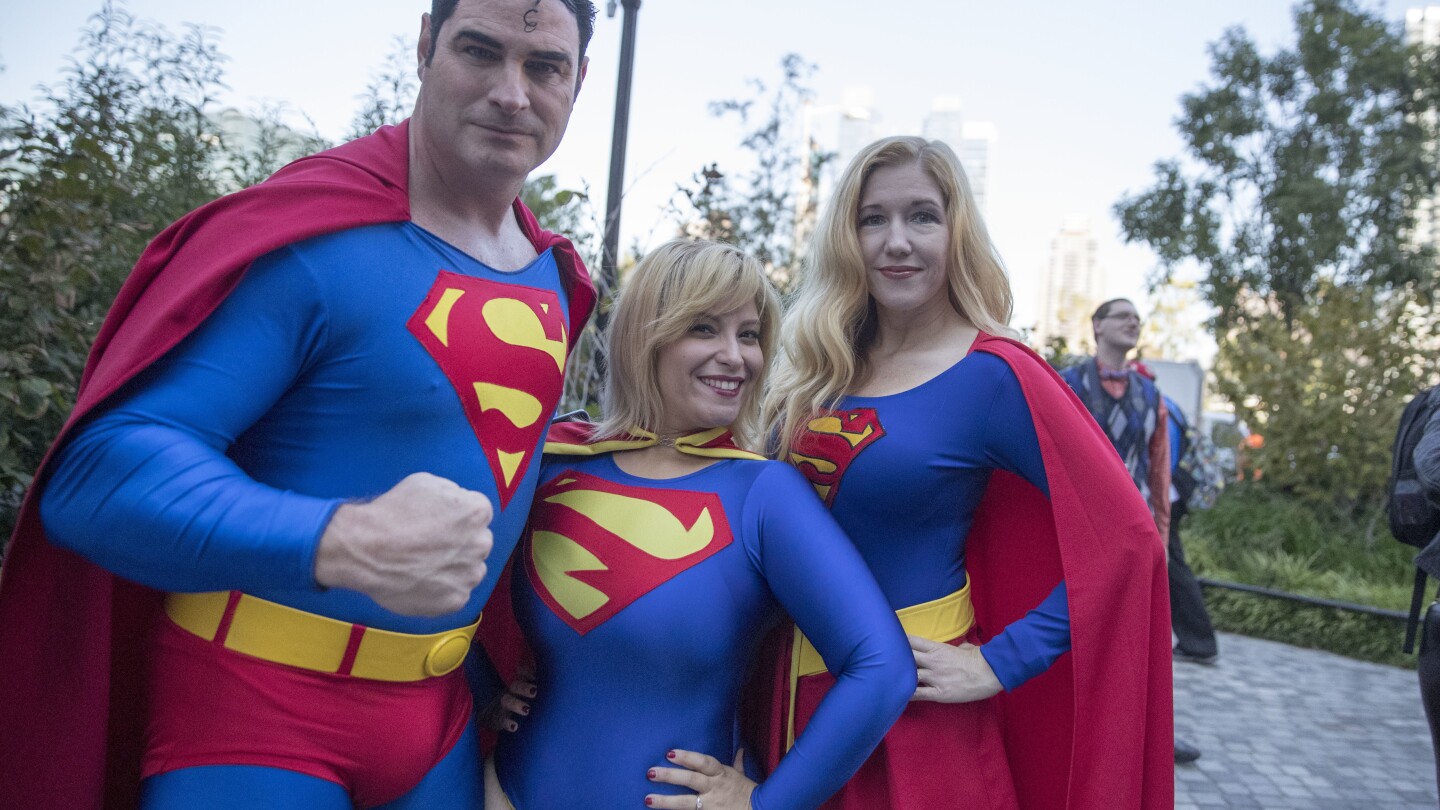Lifestyle
This federal rule helped clear air over America’s most beloved parks. Trump’s EPA wants to kill it

During a hike in the Great Smoky Mountains National Park in 1995, Don Barger climbed Chilhowee Mountain hoping to gaze across the valley below. All he saw was a wall of gray haze.
Today, he said, he can see some 50 miles (80 kilometers) across that same valley to the Cumberland Mountains.
A 26-year-old federal regulation known as the regional haze rule has helped cut down on pollution over national parks, wilderness areas and tribal reservations, restoring some of the nation’s most spectacular natural vistas for outdoor lovers like Barger. But conservationists fear those gains may be lost after President Donald Trump’s administration announced in March the rule is among dozens of landmark environmental regulations that it plans to roll back.
“It means a promise that was made to the American public is lost,” Barger, 74, said. “More and more generations of people are going to grow up as ignorant as I was, not realizing what I’m missing and not seeing.”
Congress pushes to clean air over parks, wilderness areas
Haze forms when small particles of air pollution, such as sulfur dioxide or nitrogen oxides, scatter and absorb sunlight, blurring views and decreasing visibility.
Congress amended the Clean Air Act in 1977 to make restoring and maintaining visibility a goal for 156 national parks, wilderness areas, wildlife refuges and tribal reservations across 36 states. That includes places like the Great Smoky Mountains National Park in North Carolina and Tennessee; Grand Canyon National Park; Glacier National Park; and the Boundary Waters Canoe Area Wilderness.
After years of drafting and litigation, the U.S. Environmental Protection Agency adopted regulations known as the regional haze rule in 1999 to implement the amendments.
The rule calls for attaining natural visibility conditions by the year 2064 and mandates that states come up with plans that include limitations on emissions, compliance schedules and monitoring strategies. Older facilities that emit pollution, such as coal-fired power plants, must adopt mitigation technology such as scrubbers or shut down periodically to decrease overall annual emissions.
A work in progress
The states’ plans have been plagued with delays as the EPA approves parts of them and rejects others. For example, two big oil- and coal-producing states, North Dakota and Wyoming, and industry groups filed petitions in federal court in January seeking review of EPA decisions rejecting their plans, according to the Harvard Law School’s Environmental and Energy Law Program.
The rule works in conjunction with other federal antipollution regulations, but it’s been crucial in clearing the skies over national parks and wilderness areas.
An Associated Press analysis of data from a nationwide network of monitoring sites from 1999, when the rule was implemented, through 2023 shows 93% of the parks and wilderness areas have seen improved air quality on clear days. No parks or wilderness areas have seen any notable worsening in visibility.
Visibility in the Great Smoky Mountains National Park was twice as good on a typical clear day in 2023 as it was in 1999, marking the biggest improvement among the national parks.
The EPA estimates that between 2007 and 2018 the rule has cut 500,000 tons of sulfur dioxide and 300,000 tons of nitrous oxides annually. The average visual range has increased from 90 miles to 120 miles (144 kilometers to 193 kilometers) in some western parks and from 50 to 70 miles (80 kilometers to 112 kilometers) in some eastern parks, according to the Harvard program.
‘Most consequential day of deregulation’
Trump’s EPA administrator, Lee Zeldin, announced March 12 that the agency would look to roll back 31 landmark environmental regulations, including the regional haze rule. Zeldin called the announcement the “most consequential day of deregulation in American history” and said in an essay published in the Wall Street Journal that the administration is “driving a dagger through the heart of climate-change religion.”
Asked for comment on the regional haze rule, the EPA said they want to better account for pollution from outside the U.S. and from natural sources and avoid unnecessary burdens for states and industry.
Has the rule hurt energy producers?
In a cost-benefit analysis of the rule before it took effect, the EPA found it would cost energy producers up to $98 billion by 2025 while providing about $344 billion in benefits such as health care savings.
Producers argue that the haze rule has done its job and it doesn’t make sense to continue to impose costs on them.
“This is a matter of diminishing returns,” said Jonathan Fortner, interim president and CEO of the Lignite Energy Council, which advocates for North Dakota’s coal industry. “The air is clean, the data proves it, and the science backs that up. The rule’s being misapplied, not because we disagree with clean air goals, but because we’re already there.”
Two federal properties in North Dakota are subject to the rule, the Lostwood National Wildlife Refuge and Theodore Roosevelt National Park. The AP analysis found both sites have seen dramatic visibility improvements over the five years from 2019 to 2023.
EPA officials did not respond to an AP request for a list of power plants that have closed due to the regional haze rule. A number of energy industry groups did not return repeated requests for comment, including the U.S. Energy Association and the National Utility Contractors Association.
What’s next for the parks?
Advocates of the rule say eliminating it could lead to reduced tourism and the economic boom visitors bring to national park regions. The National Park Service estimates 325 million people visited national parks in 2023, spending $26.4 billion in gateway communities.
Nothing appears likely to change overnight. Conservationists expect the Trump administration to pursue a rollback through language revisions in the rule, a process that would require a public comment period and would likely trigger court challenges that could last years.
“I’ve watched the Great Smoky Mountains National Park emerge from the chemical haze that once enshrouded it and was getting worse,” Barger said. “It’s just this visceral sense of place. We had lost it entirely. The Clean Air Act is working and it’s a work in progress. You have to stay with it or it doesn’t work.”
___
Associated Press Science Writer Seth Borenstein contributed to this report.
___
The Associated Press’ climate and environmental coverage receives financial support from multiple private foundations. AP is solely responsible for all content. Find AP’s standards for working with philanthropies, a list of supporters and funded coverage areas at AP.org.
Lifestyle
The 250th anniversary of the Battles of Lexington and Concord opens debate over US independence
NEW YORK (AP) — The American Revolution began 250 years ago, in a blast of gunshot and a trail of colonial spin.
Starting with Saturday’s anniversary of the Battles of Lexington and Concord, the country will look back to its war of independence and ask where its legacy stands today.
The semiquincentennial comes as President Donald Trump, the scholarly community and others divide over whether to have a yearlong party leading up to July 4, 2026, as Trump has called for, or to balance any celebrations with questions about women, the enslaved and Indigenous people and what their stories reveal.
The history of Lexington and Concord in Massachusetts is half-known, the myth deeply rooted.
What exactly happened at Lexington and Concord?
Reenactors may with confidence tell us that hundreds of British troops marched from Boston in the early morning of April 19, 1775, and gathered about 14 miles (22.5 kilometers) northwest on Lexington’s town green.
Firsthand witnesses remembered some British officers yelled, “Thrown down your arms, ye villains, ye rebels!” and that amid the chaos a shot was heard, followed by “scattered fire” from the British. The battle turned so fierce that the area reeked of burning powder. By day’s end, the fighting had continued around 7 miles (11 kilometers) west to Concord and some 250 British and 95 colonists were killed or wounded.
But no one has learned who fired first, or why. And the revolution itself was initially less a revolution than a demand for better terms.
Woody Holton, a professor of early American history at the University of South Carolina, says most scholars agree the rebels of April 1775 weren’t looking to leave the empire, but to repair their relationship with King George III and go back to the days preceding the Stamp Act, the Tea Act and other disputes of the previous decade.
“The colonists only wanted to turn back the clock to 1763,” he said.
Stacy Schiff, a Pulitzer Prize winning historian whose books include biographies of Benjamin Franklin and Samuel Adams, said Lexington and Concord “galvanized opinion precisely as the Massachusetts men hoped it would, though still it would be a long road to a vote for independence, which Adams felt should have been declared on 20 April 1775.”
But at the time, Schiff added, “It did not seem possible that a mother country and her colony had actually come to blows.”
A fight for the ages
The rebels had already believed their cause greater than a disagreement between subjects and rulers. Well before the turning points of 1776, before the Declaration of Independence or Thomas Paine’s boast that “We have it in our power to begin the world over again,” they cast themselves in a drama for the ages.
The so-called Suffolk Resolves of 1774, drafted by civic leaders of Suffolk County, Massachusetts, prayed for a life “unfettered by power, unclogged with shackles,” a fight that would determine the “fate of this new world, and of unborn millions.”
The revolution was an ongoing story of surprise and improvisation. Military historian Rick Atkinson, whose “The Fate of the Day” is the second of a planned trilogy on the war, called Lexington and Concord “a clear win for the home team,” if only because the British hadn’t expected such impassioned resistance from the colony’s militia.
The British, ever underestimating those whom King George regarded as a “deluded and unhappy multitude,” would be knocked back again when the rebels promptly framed and transmitted a narrative blaming the royal forces.
“Once shots were fired in Lexington, Samuel Adams and Joseph Warren did all in their power to collect statements from witnesses and to circulate them quickly; it was essential that the colonies, and the world, understand who had fired first,” Schiff said. “Adams was convinced that the Lexington skirmish would be ‘famed in the history of this country.’ He knocked himself out to make clear who the aggressors had been.”
A country still in progress
Neither side imagined a war lasting eight years, or had confidence in what kind of country would be born out of it. The founders united in their quest for self-government but differed how to actually govern, and whether self-government could even last.
Americans have never stopped debating the balance of powers, the rules of enfranchisement or how widely to apply the exhortation, “All men are created equal.”
“I think it’s important to remember that the language of the founders was aspirational. The idea that it was self-evident all men were created equal was preposterous at a time when hundreds of thousands were enslaved,” said Atkinson, who cites the 20th-century poet Archibald MacLeish’s contention that “democracy is never a thing done.”
“I don’t think the founders had any sense of a country that some day would have 330 million people,” Atkinson said. “Our country is an unfinished project and likely always will be.”
Lifestyle
Sweets from the sky! A helicopter marshmallow drop thrills kids in suburban Detroit

ROYAL OAK, Mich. (AP) — It’s spring in Detroit — warm weather, a few clouds, and a 100% chance of marshmallow downpours.
The source? A helicopter zooming above the green lawn of Worden Park on Friday, unloading sack-fulls of fluffy treats for hundreds of kids waiting eagerly below, some clutching colorful baskets or wearing rabbit ears.
The children cheered and pointed as the helicopter clattered by on its way to the drop zone. Volunteers in yellow vests made sure kids didn’t rush in and start grabbing marshmallows until after the deluge was complete.
For anyone worried about hygiene, don’t fret. The annual Great Marshmallow Drop isn’t about eating the marshmallows — kids could exchange them for a prize bag that included a water park pass and a kite.
The marshmallow drop has been held for over three decades in the Detroit suburb of Royal Oak, Michigan, hosted by Oakland County Parks.
One toddler, Georgia Mason, had no difficulty procuring a marshmallow at her first drop, her dad Matt said.
“Probably the most exciting part was seeing the helicopters. But once we saw the marshmallows drop, we got really excited,” Matt Mason said.
“And, yeah, we joined the melee,” he said, “We managed to get one pretty easy.”
Organizers said 15,000 marshmallows were dropped in all.
The helicopter made four passes, dropping marshmallows for kids in three age categories: 4-year-olds and younger, 5-7-year-olds, and those ages 8 to 12. A drop for kids of all ages with disabilities came later in the day.
“We do it because it’s great for community engagement,” Oakland County recreation program supervisor Melissa Nawrocki said.
“The kids love it,” she continued. “The looks on their faces as they’re picking up their marshmallow and turning in the marshmallow for prizes is great.”
Lifestyle
AP report: Superman comics have religious and moral themes

Superman comics are not overtly religious. Yet faith and morality have been baked into this superhero character who was born Kryptonian, raised Methodist and created by two young Jewish men in 1930s Cleveland.
Superman’s character has been portrayed in the mold of Christ and Moses given how he constantly upholds the ideals of self-sacrifice, powerful leadership and compassion. While scholars, comic book writers and fans alike are struck by the religious undertones in Superman comics, they all agree that what sets Superman apart is his ability to bring hope in a hopeless world.
Superman Day and the ‘Superman’ summer movie release
Friday (April 18) marks the 87th anniversary of the original superhero’s birth. It also is the date Superman made his debut in an Action Comics issue.
There is much excitement in the Superman fanverse this year because of the much-anticipated ‘Superman’ movie directed by James Gunn, starring David Corenswet, the first Jewish actor to play Superman in a major film.
On his Instagram page on April 18, 2024, Gunn shared a photo of himself, Corenswet and Rachel Brosnahan who plays Lois Lane in the upcoming film, reading among several comic books, a reproduction of Action Comics #1 — the very first one featuring the Man of Steel.
In his Instagram post, Gunn also paid tribute to the superhero, saying: “He gave us someone to believe in, not because of his great physical power, but because of his character and determination to do right no matter what.”
Gunn’s film promises a return to a version of a vulnerable Superman who is rooted in values espoused by most faiths — goodness, compassion and hope.
Superman’s Jewish roots
Samantha Baskind, professor of art history at Cleveland State University, is Jewish and sees numerous parallels between Superman’s origin story and the history of Jews.
She says Superman’s solitary flight from Krypton in a small spacecraft is reminiscent of how Moses’ mother placed him in a papyrus basket and left him on the Nile, seeing it as his best chance of survival.
Some also compare Superman’s backstory to the Kindertransport, she said, referring to a humanitarian rescue program that transported nearly 10,000 children, mostly Jewish, from Nazi-controlled territories to Great Britain in 1938 and 1939. In Superman’s Kryptonian name, Kal-El, chosen by his original Jewish creators Jerry Siegel and Joe Shuster, the “El” in Hebrew connotes God.
“There’s also the thinking that Siegel and Shuster created Superman because they were these two, skinny, young Jewish men who couldn’t go out and fight Hitler, but Superman fought Nazis on the cover of their comic books,” Baskind said.
In some early editions, Superman held Hitler by his Nazi uniform as he begged for mercy.
Strong appeal to diverse groups
Superman is relatable to diverse populations regardless of religion, race or ethnicity.
Gene Luen Yang, who has written several Superman comics, sees his own experience as a Chinese American mirrored in Superman’s story — caught between two worlds and two cultures. Yang says he had one name at home and another at school, just like Superman. So, even though he is a practicing Catholic, Yang says he relates more to Superman’s Jewish roots.
Despite the religious undertones, Superman also appeals to those who are religiously unaffiliated, said Dan Clanton, professor of religious studies at Doane University in Nebraska, adding that the superhero’s story “truly encapsulates American civil religion.”
Neal Bailey, a longtime contributor to Superman Homepage, a fan site, is an atheist. He views Superman as a “philosophical pragmatist” with the ability to solve the most complex problems with the least amount of harm.
“He actually goes beyond religion to see our commonalities,” Bailey said. “Superman wouldn’t care about people’s religious beliefs. He would care more about whether they are living up to their human potential.”
Superman inspires humans to do better
Grant Morrison, one of the best-known writers of Superman comic books, said in a 2008 interview that humans become what they imitate, which is why he made Superman an inspirational character.
Superheroes have received less-than-flattering treatment in recent films and television shows. For example, in “The Boys,” a comic book turned Amazon Prime series, the Superman-like character, Homelander, is a government-sponsored hero whose smiling exterior conceals the heart of a sadist. Gunn’s Superman is expected to change that trajectory with a superhero who will reinforce the character’s core value of preserving life at any cost.
An altruistic view of Superman can be found in the recently concluded “Superman & Lois” television series on the CW Network in which after defeating Lex Luthor in a final battle, the couple settles down in a small town and starts a foundation to help others.
“I didn’t just want to be a hero that saves people,” the Superman character played by Tyler Hoechlin says in an epilogue to the series. “I wanted to connect with them. To change their lives for the better.”
___
Associated Press religion coverage receives support through the AP’s collaboration with The Conversation US, with funding from Lilly Endowment Inc. The AP is solely responsible for this content.
-

 Conflict Zones2 days ago
Conflict Zones2 days agoHaiti in ‘free fall’ as violence escalates, rights group warns | Armed Groups News
-

 Sports2 days ago
Sports2 days agoJu Wenjun: Chinese grandmaster makes history by winning fifth Women’s World Chess Championship
-

 Africa2 days ago
Africa2 days agoEuropean Union announces new asylum measures
-

 Middle East2 days ago
Middle East2 days agoHamas accuses Israel of weaponising aid as Gaza’s hunger crisis worsens | Gaza News
-

 Lifestyle2 days ago
Lifestyle2 days agoPicking a team from bars to beam and hoping for 10s: Fantasy leagues in gymnastics are a thing
-

 Middle East2 days ago
Middle East2 days agoPalestinian photographer Samar Abu Elouf wins world’s top photo prize | Gaza News
-

 Sports2 days ago
Sports2 days agoArsenal reaches first Champions League semifinal in 16 years, with Inter Milan also advancing
-

 Sports2 days ago
Sports2 days agoBarcelona player Mapi León banned for two matches after appearing to touch the groin of an opponent



